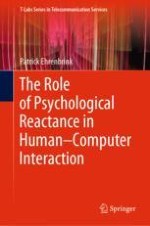2020 | OriginalPaper | Buchkapitel
8. Reactance Scale for Human–Computer Interaction
verfasst von : Patrick Ehrenbrink
Erschienen in: The Role of Psychological Reactance in Human–Computer Interaction
Aktivieren Sie unsere intelligente Suche, um passende Fachinhalte oder Patente zu finden.
Wählen Sie Textabschnitte aus um mit Künstlicher Intelligenz passenden Patente zu finden. powered by
Markieren Sie Textabschnitte, um KI-gestützt weitere passende Inhalte zu finden. powered by
